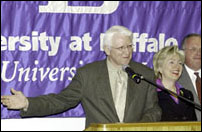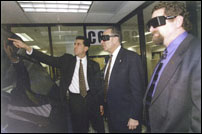The Buffalo Center of Excellence in Bioinformatics is an integral part
of Pataki's plan to develop centers of excellence across the state to
harness the strengths of universities and the private sector to create
strategically targeted high-technology centers of innovation, all aimed
at spurring economic development and creating jobs.
During the past year, the center has attracted funding from major national
corporations.
In addition to the "initial installment" of $50 million from New York
State, Pataki noted the following commitments in software, hardware, venture
capital, cash and equipment to date from the industry partners:
- Veridian will contribute $62.5 million
- Compaq has pledged $42.6 million
- Informax will provide $20.8 million
- A group of Western New York businesses is investing $15 million
- Stryker Communications is providing $7.2 million to create a communications
network for the center
- Dell Computer Corp. and Sun Microsystems Inc. together are providing
more than $1 million
Other partners include Invitrogen Corp., Q-Chem, SGI, Amersham Pharmacia
Biotech, AT&T, Wyeth Lederle, Human Genome Sciences, Inc. and the Alfred
P. Sloan Foundation
The level of the commitment of New York State and the industry and academic
partners, Pataki said, will assure the center will be "the state-of-the-art
facility" for bioinformatics, "not just in the United States, but in the
world."
He predicted that it will "transform Western New York into a 21st-century
economy," creating "thousands of jobs, thousands of high-paying, high-tech,
21st-century jobs" for residents of Buffalo, Western New York and New
York State.
SUNY Chancellor Robert L. King, who also appeared at the Dec. 6 news
conference, pointed out that when he was appointed chancellor, he told
the campus presidents and members of the board of trustees that he thought
it should be at the top of his agenda "to fully integrate" the state university
into the state's economy, "linking our graduates and faculty, our libraries
and research capabilities into New York's economy."
The governor's "centers of excellence concept" is helping SUNY realize
that goal, King added.
"Here at UB, and at our campuses at Albany and at Stony Brook, new words
are creeping into our lexicon—bioinformatics, nanosciences and genomics,
to name a few," he said.
"This is happening because of this marvelous integration of the power
and capabilities of these wonderful universities with the business community
and the support that we get from our government.
"This effort is transforming our state with strategic investments into
what this country's economic powerhouse for the 21st century will be."
President William R. Greiner thanked Pataki for his vision and leadership
and his "continuing commitment to Buffalo Niagara. It is much appreciated
in this region and we will work to make you proud."
Pataki said the center will be headquartered in a 150,000-square-foot
facility to be built near Buffalo's medical corridor. The facility, he
added, will house drug-design and research laboratories, high-performance
computational facilities, 3-D visualization capabilities, product commercialization
space and workforce training facilities.
Speaking on behalf of the center's corporate partners, Bill Blake, worldwide
vice president for high performance technical computing with Compaq, said
the center "will be a very successful example of a private-public partnership
moving ahead in science and using that science to generate a strong industrial
base in this region."
Blake said Compaq has been involved with centers of excellence in the
United Kingdom, Switzerland and Taiwan. Its relationship with the Buffalo
center, he added, will be "the most serious and is the highest level of
commitment we're going to have."
Referring to the head of the company that succeeded in sequencing the
human genome—former UB faculty member Craig Venter and his company,
Celera Genomics—Blake noted that the Buffalo Center of Excellence
in Bioinformatics will take the products of that revolutionary research
and, in turn, create future scientific revolutions.
"This center will spawn the next generation of Dr. Venters and the next
generation of Celera Genomics here in the Buffalo area," he said.


